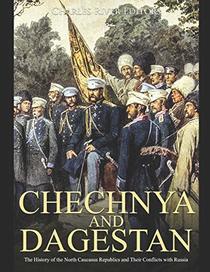Chechnya and Dagestan share some factors and are different in some ways. This is an interesting explanation of both region's history, culture, and religions. Because of their shared religion (in spite of the fact that they believe in differing sects of Islam), they are both anti-authoritarianism and both have tried to stay out of Russia's orbit for generations. Much of this book is about the extended and frustrating wars and conflicts between the Chechens and Dagestani and powers that sought to control them, such as the Persians, Ottomans, and Russians.
Both regions have sought autonomy, with varying success. Russians interfered in these regions, originally under the guise of saving the Orthodox Christians there (Russians are tacitly Orthodox Christians).
CHECHNYA --
It is difficult to get to this country because it is mostly mountainous with steep valleys. It is remote and difficult to navigate. Recent finds indicate that people have been in Chechnya since 8000 BCE. Since about the 16th-century, Chechens have been Sunni Muslims. However, a growing group of Chechens are Sufis; Sufism emphasizes secrecy and mysticism, which is well-suited to their need to observe their religion in secret, under the Russians.
The Russians have been a thorn in the sides of Chechens since the 16th-century. In the late 1800s, Chechens and Ingush left the Caucasus region for the lands of the Ottomans because of the pressure by the Russians. It is estimated that about 80% of Chechens and Ingush left the Caucasus during that time, which lowered the Chechens' resistance to Russian rule. To further Chechnya's hatred of Russia, the entire Chechen population was deported to Siberia and northern parts of Kazakhstan by the USSR government. This was partly payback for the Chechens' collaboration with the Nazis during the war.
DAGESTAN --
Bordering water, Dagestan is easier to get to and has had a more turbulent history (because of the ease of traveling there). They converted to Islam long before the Chechens and are mostly Sunni. After the Russo-Persian War (1804 - 1813), Persia ceded vast territories to the Russians, including Dagestan.
When necessary, Dagestan and Chechnya have overcome their religious rivalries (Dagestani's think the Chechen's Sufism is strange) to fight together. As turmoil spilled over from Chechnya (and their conflict with Russia) in the 1990s, 2000s, and 2010s, Dagestan got caught up in the violence and became a dangerous place to visit. Because of the increased violence from the Russians, Dagestan has become more radicalized (seeking a jihad). Dagestan maintains a small, radical, secret fighting force that continues to plague the Russians in their country. Today, Dagestan is one of the poorest regions of the Russian Federation.
The Boston Marathon bombing was done by two brothers from Dagestan and Chechnya, who were radicalized in Dagestan immediately before the assault in America.
Both regions have sought autonomy, with varying success. Russians interfered in these regions, originally under the guise of saving the Orthodox Christians there (Russians are tacitly Orthodox Christians).
CHECHNYA --
It is difficult to get to this country because it is mostly mountainous with steep valleys. It is remote and difficult to navigate. Recent finds indicate that people have been in Chechnya since 8000 BCE. Since about the 16th-century, Chechens have been Sunni Muslims. However, a growing group of Chechens are Sufis; Sufism emphasizes secrecy and mysticism, which is well-suited to their need to observe their religion in secret, under the Russians.
The Russians have been a thorn in the sides of Chechens since the 16th-century. In the late 1800s, Chechens and Ingush left the Caucasus region for the lands of the Ottomans because of the pressure by the Russians. It is estimated that about 80% of Chechens and Ingush left the Caucasus during that time, which lowered the Chechens' resistance to Russian rule. To further Chechnya's hatred of Russia, the entire Chechen population was deported to Siberia and northern parts of Kazakhstan by the USSR government. This was partly payback for the Chechens' collaboration with the Nazis during the war.
DAGESTAN --
Bordering water, Dagestan is easier to get to and has had a more turbulent history (because of the ease of traveling there). They converted to Islam long before the Chechens and are mostly Sunni. After the Russo-Persian War (1804 - 1813), Persia ceded vast territories to the Russians, including Dagestan.
When necessary, Dagestan and Chechnya have overcome their religious rivalries (Dagestani's think the Chechen's Sufism is strange) to fight together. As turmoil spilled over from Chechnya (and their conflict with Russia) in the 1990s, 2000s, and 2010s, Dagestan got caught up in the violence and became a dangerous place to visit. Because of the increased violence from the Russians, Dagestan has become more radicalized (seeking a jihad). Dagestan maintains a small, radical, secret fighting force that continues to plague the Russians in their country. Today, Dagestan is one of the poorest regions of the Russian Federation.
The Boston Marathon bombing was done by two brothers from Dagestan and Chechnya, who were radicalized in Dagestan immediately before the assault in America.




